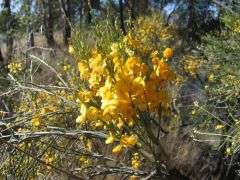Viminaria
Viminaria juncea is the single species[Note 1] in the genus Viminaria endemic to Australia.[3][2][1] The genus is in the pea family Fabaceae. It is colloquially known as native broom after its resemblance to the related European broom plants.[4] The Noongar peoples know the plant as koweda.[5]
| Viminaria | |
|---|---|
 | |
| Viminaria juncea | |
| Scientific classification | |
| Kingdom: | |
| (unranked): | |
| (unranked): | |
| (unranked): | |
| Order: | |
| Family: | |
| Subfamily: | |
| (unranked): | |
| Genus: | Viminaria |
| Species: | V. juncea |
| Binomial name | |
| Viminaria juncea (Schrad.) Hoffmanns. | |
Originally described in 1795 by Schrader as Sophora juncea,[6] it was given its current binomial name by Hoffmannsegg in 1824.[7] The genus name is derived from the Latin vimineus "switch", and the species name from Latin juncus "rush", hence "rush-like". Alternate names include golden spray, native broom and swishbush.[8]
Native broom grows as an erect or weeping shrub 1.5–6 m (4.9–19.7 ft) high and 1–2.5 m (3.3–8.2 ft) wide. It has a smooth trunk and ascending branches while the minor branchlets often droop.[8] The long and thin leaves are essentially petioles and measure 3–25 cm (1.2–9.8 in) in length.[9] Flowering occurs from September to January, the flowers growing on racemes to about 25 cm (10 in) in length. Measuring 0.8 cm (0.31 in) in diameter, they are yellow with an orange corolla and are typically pea-shaped. They are followed by small pods containing single seeds.[8]
The preferred habitat is swampy areas near the coast across southern Australia, from the vicinity of Geraldton in Western Australia southwards to Esperance,[10] and in the east in coastal Queensland, New South Wales, Victoria, and South Australia.[9]
Native broom is a fast-growing plant in the garden, but can lose vigor once about 5 or 10 years old. It prefers an acidic to neutral soil with ample moisture and is hardy to temperatures of −4 °C. Plants grown from seed are sturdier than cutting-grown specimens.[8]
Notes
References
- "The Plant List entry for Viminaria". The Plant List. Royal Botanic Gardens, Kew and the Missouri Botanical Garden. 2013. Retrieved 15 January 2017.
- USDA; ARS; National Genetic Resources Program. "GRIN species records of Viminaria". Germplasm Resources Information Network—(GRIN) [Online Database]. National Germplasm Resources Laboratory, Beltsville, Maryland. Retrieved 15 January 2017.
- "ILDIS LegumeWeb entry for Viminaria". International Legume Database & Information Service. Cardiff School of Computer Science & Informatics. Retrieved 15 January 2017.
- Australian National Botanic Gardens (16 December 2003). "Viminaria juncea". Growing Native Plants. Canberra, ACT: Australian National Botanic Gardens, Commonwealth of Australia.
- "Noongar names for plants". kippleonline.net. Archived from the original on 20 November 2016. Retrieved 16 December 2016.
- "Sophora juncea Schrad". Australian Plant Name Index (APNI), IBIS database. Centre for Plant Biodiversity Research, Australian Government.
- "Viminaria juncea (Schrad.) Hoffmanns". Australian Plant Name Index (APNI), IBIS database. Centre for Plant Biodiversity Research, Australian Government.
- Eliott, Rodger W.; Jones, David L.; Blake, Trevor (2010). Encyclopaedia of Australian Plants Suitable for Cultivation: Volume 9—Sp–Z. Port Melbourne: Lothian Press. p. 440. ISBN 978-0-7344-0974-4.
- B. Wiecek. "New South Wales Flora Online: Viminaria juncea". Royal Botanic Gardens & Domain Trust, Sydney, Australia. Retrieved 10 February 2013.
- "Viminaria juncea (Schrad. & J.C.Wendl.) Hoffmanns". FloraBase. Western Australian Government Department of Parks and Wildlife.
External links

